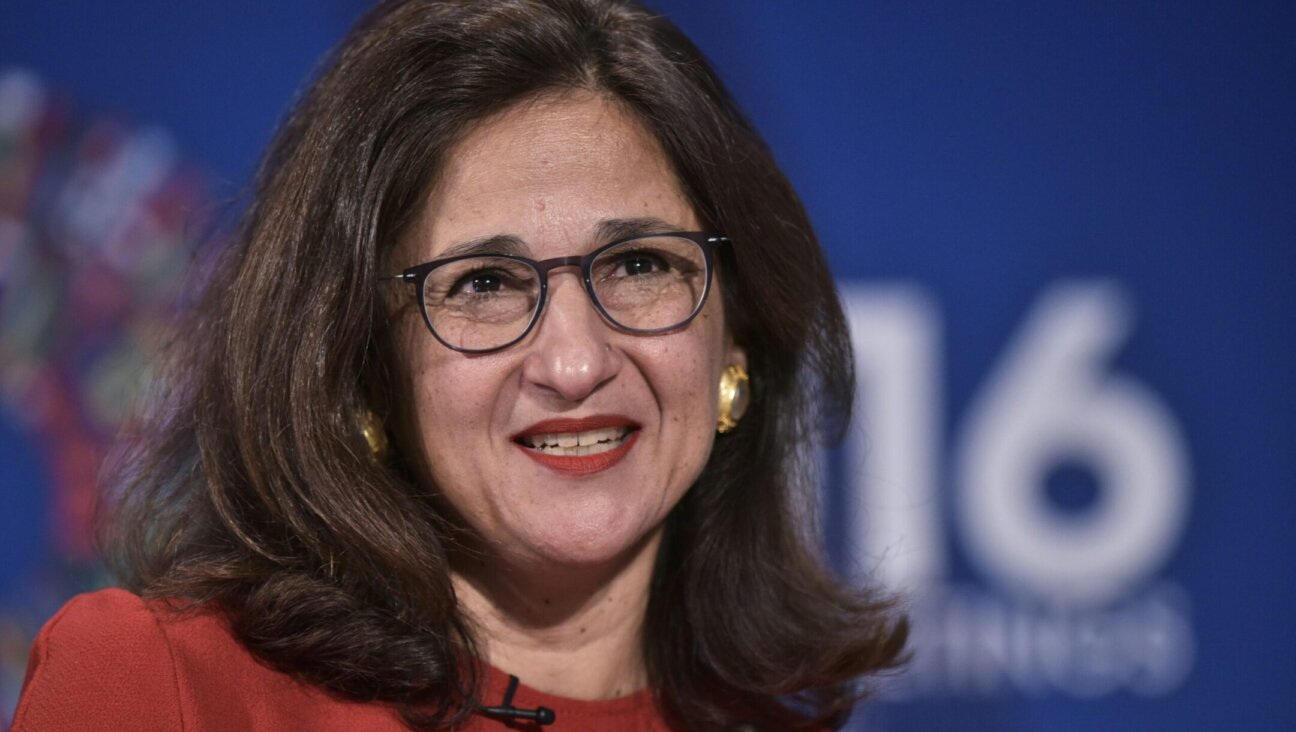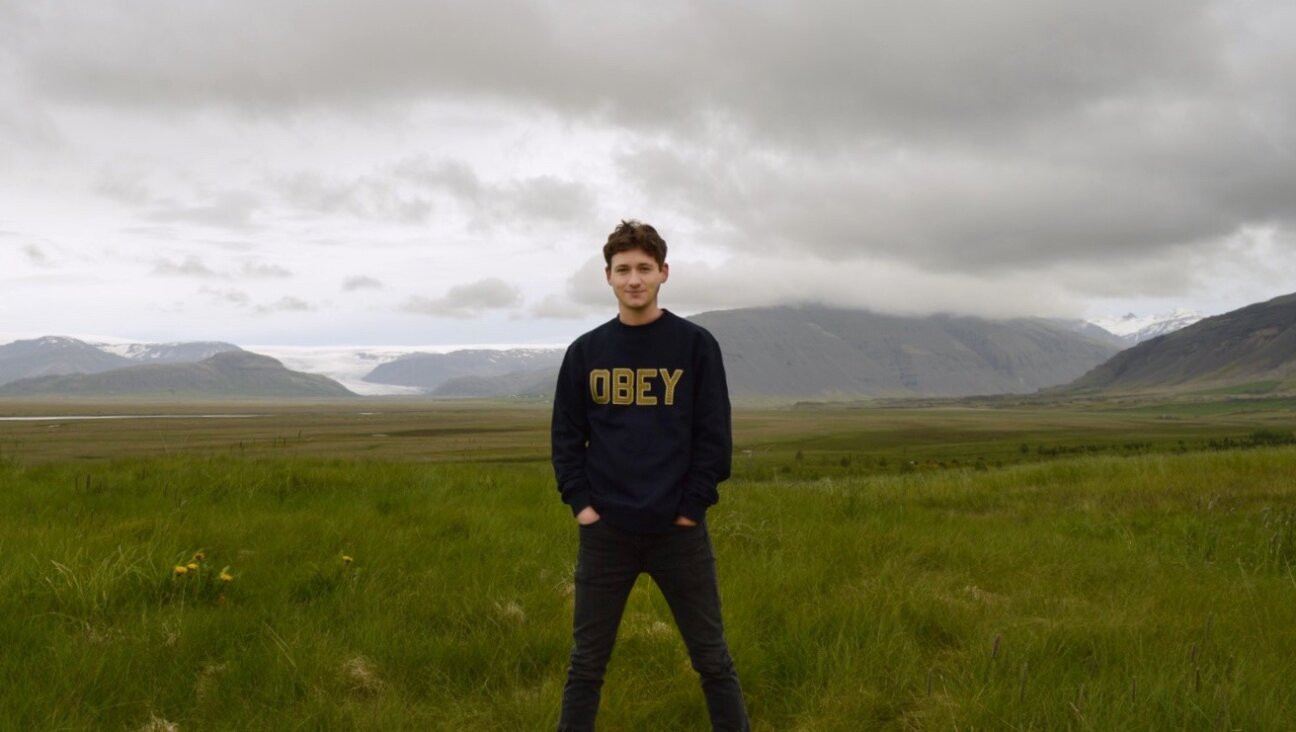Sephardic Music Comes Out of the Shadows
More than faithfully reproducing centuries-old Sephardic melodies, an emerging group of American Jewish songwriters is developing a Jewish world-beat sound that includes Sephardic melodies and instruments, whether sung in Hebrew, English, Ladino (Sephardic Judeo-Spanish) or even Yiddish.
In St. Louis, for example, Jewish Renewal Rabbi James Stone Goodman improvises darting lines on the oud, the Middle Eastern precursor to guitar, and sings his interpretations of Hebrew and Ladino songs preserved from pre-World War II Middle Eastern Jewish communities.
The songs appear on two new independently released CDs, “Dvar Guitar” and “The Sefirot,” and in concerts that Goodman said feel too holy to call performances. “The music has so transformed my life that my concerts have become ceremonies,” he explained.
Los Angeles-based singer-guitarist Bruce “RebbeSoul” Burger has moved from standard Jewish rock to infectious Sephardic-style compositions with Hebrew lyrics on the independently released CDs “Fringe of Blue” (1996) and the new “Change the World with a Sound.”
He said his 10-year immersion in Jewish music parallels his own spiritual quest. However, his Sephardic jams move some of his listeners in other ways. “Whenever we play, a belly-dance kind of scene seems to follow us around,” he said. “Some of them even come in costume. It’s a trippy thing.”
In New York, singer-songwriter Basya Schechter leads Pharaoh’s Daughter, an eclectic quintet whose songs reference Sephardic music, whether through the use of a hand drum and Schechter’s oud-like guitar riffs or by easing into a hip-shaking groove behind Schechter’s sinuous oud-playing and powerful singing.
The evidence is on three CDs — the independently released “Daddy’s Pockets” (1999), “Out of the Reeds” (Knitting Factory, 2000) and “Exile” (Knitting Factory, 2002) — and in the band’s eclectic concerts, which include dances performed and choreographed by Schechter and flutist Daphna Mor.
These musicians head a list of Sephardic innovators along with Divahn, an all-woman quartet from Austin, Texas, that interprets Ladino and other Sephardic folk and liturgical songs on Western and Middle Eastern instruments and even the Australian aboriginal didgeridoo; New York pianist, singer and producer Anthony Coleman, and two New York duos: Zohar, which mixes avant-garde pianist Uri Caine’s jazz with the voice of Moroccan-born tenor Aaron Bensoussan, and Oren Bloedow and Jennifer Charles, leaders of the rock band Elysian Fields, who tackle Sephardic melodies on “La Mar Enfortuna” (Tzadik, 2001).
Sephardic music combines lilting melodies in minor keys played on stringed instruments, usually guitar or oud, along with hand drums and flute. Its more Arabic stylings exude a feeling of floating. The older Spanish style feels more rooted. Traditional topics are liturgical or romantic.
“It’s an excellent music,” Goodman said. “It’s Mediterranean; it’s Eastern. It has as many qualities of the Eastern, Oriental music as it does of Western music. That gives it a different quality. Its holiness aspect is profound. Also, there’s a kind of quiet, yearning quality, a touch of sadness.”
Those attributes are attracting fans, the musicians say. “I think people are getting into it,” said Goodman. “People are more interested in it now.”
Schechter agreed. “I think people are more drawn to it,” she said. “Klezmer came first as a revival movement. Sephardic music is getting more popular now.”
Klezmer, the music of the Ashkenazi Jews, was a favorite of American Jews and even non-Jews in the first half of the 20th century. Klezmer’s popularity faded until the band Klezmorim ushered in a revival in the late 1970s that paralleled a renewed interest in all things Jewish. New bands have combined klezmer with jazz and other experimental musical styles.
Meanwhile, Debbie Friedman and the late Rabbi Shlomo Carlebach were spearheading a groundswell of singers who wrote new melodies on acoustic guitar and piano to age-old Jewish prayers.
Traditional Sephardic music always had its champions, but the lithe melodies of the oud and the dancing rhythms of the hand drums remained outside the American Jewish mainstream until the 1990s. That’s when World Music, the shared international grab bag of songs and sounds, began to pervade the culture.
Its performers included three Sephardic-influenced Israeli musicians — the late singer Ofra Haza, singer-songwriter David Broza and singer-percussionist Achinoam Nini — often called Noa — who brought a modern exotic edge to Jewish songs.
“People always had thought of klezmer music when they thought of Jewish music,” said Burger. “But the world is getting smaller. The Mizrahi [Eastern] influence is becoming more apparent. It is becoming more of a trend.”
Promoter Moishe Rosenfeld of Golden Land Concerts & Connections, which represents Noa, Pharaoh’s Daughter and Divahn, won’t say that Sephardic music’s growth has reached trend status. “I think it’s got a ways to go,” he said. “It’s definitely in the cards. The music is exciting, attractive, just as klezmer was and is. Klezmer attracted people looking to feel a certain way about their Judaism. Sephardic music is that way also, though it’s a little more of a stretch because it isn’t part of most Jews’ backgrounds.”
That’s true even for many of the musicians responsible for the Sephardic resurgence.
Goodman said that when he bought an oud in Israel years ago, he couldn’t find a teacher in the United States. When Israeli-Arab oud master Taiseer Elias performed in St. Louis seven years ago, Goodman took his oud and sat in the front row, which made for an easy introduction to Elias. Goodman soon after went to study with the master in Israel.
Schechter grew up in an Orthodox household in Brooklyn. Her stepmother had been married to a Syrian, so Schechter was familiar with Sephardic music. She went to Israel to attend an Ashkenazic Orthodox seminary, but it was non-religious Judaism that she found attractive.
Expelled from the seminary over philosophical differences, she began to travel — to Egypt, through Africa, to Turkey — soaking up culture and music. “I was a dancer before I was a musician,” she said. “The music that made me move in an internal way was Sephardic music.”
Returning to the United States, she combined the Sephardic and other exotic music styles she studied with lyrics in Hebrew and sometimes Yiddish, and recently with English lyrics about her spiritual quest.
Burger included several Ashkenazic songs on his album “RebbeSoul-O.” Then he heard Israeli oud player Yair Dalal perform with two drummers. “I wondered if my band could play my stuff in that format. I grabbed a couple of percussionists, and it sounded great,” he said.
For the next CD, “I decided I really wanted to go in a Jewish direction,” he said. So he began to study Jewish music and texts. “It became this parallel musical and spiritual journey. I played songs from Sephardic music books and decided, that’s good enough for me.”
Burger sees Sephardic music as a cultural bridge through its status as a World Music. He plays it in nightclubs as well as Jewish venues. “Showing people who we are as a people gives them a sense of our soul,” he said.

I hope you appreciated this article. Before you go, I’d like to ask you to please support the Forward’s award-winning journalism this Passover.
In this age of misinformation, our work is needed like never before. We report on the news that matters most to American Jews, driven by truth, not ideology.
At a time when newsrooms are closing or cutting back, the Forward has removed its paywall. That means for the first time in our 126-year history, Forward journalism is free to everyone, everywhere. With an ongoing war, rising antisemitism, and a flood of disinformation that may affect the upcoming election, we believe that free and open access to Jewish journalism is imperative.
Readers like you make it all possible. Right now, we’re in the middle of our Passover Pledge Drive and we need 500 people to step up and make a gift to sustain our trustworthy, independent journalism.
Make a gift of any size and become a Forward member today. You’ll support our mission to tell the American Jewish story fully and fairly.
— Rachel Fishman Feddersen, Publisher and CEO
Join our mission to tell the Jewish story fully and fairly.
Our Goal: 500 gifts during our Passover Pledge Drive!






















